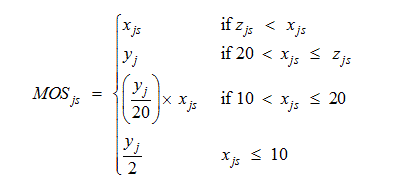- Surveys & Programs
- Data & Tools
- Fast Facts
- News & Events
- Publications & Products
- About Us
NAEP Technical DocumentationComputation of Measures of Size for the 2011 Assessment
In designing each school sample, five objectives underlie the process of determining the probability of selection for each school and how many students are to be sampled from each selected school containing the respective grade:
- to meet the target student sample size for each grade;
- to select an equal-probability sample of students;
- to limit the number of students selected from any one school;
- to ensure that the sample within a school does not include a very high percentage of the students in the school, unless all students are included; and
- to reduce the rate of sampling of small schools, in recognition of the greater cost and burden per student of conducting assessments in such schools.
The goal in determining the school's measure of size is to optimize across the last four objectives in terms of maintaining the accuracy of estimates and the cost effectiveness of the sample design. In certain jurisdictions, a census of students was taken so as to meet, as nearly as possible, the target student sample size. Elsewhere, to meet the target student sample and achieve a reasonable compromise among the other four objectives above, the following algorithm was used to assign a measure of size to each school based on its enrollment per grade as indicated on the sampling frame.
The preliminary measures of size (MOS) were set as follows:

where xjs is the estimated grade enrollment for jurisdiction j and school s, yj the target within-school student sample size for jurisdiction j, and zj the within-school take-all student cutoff for jurisdiction j.
For grade 4, the target sample sizes and take-all cutoffs were 63 and 70, respectively. For grade 8, the target sample sizes and take-all cutoffs varied by jurisdiction due to the pilot and special studies samples. The target sample sizes and take-all cutoffs ranged from 63 to 114 and 70 to 125, respectively. For the majority of the states and TUDAs, the target sample sizes were 89 and 63 and take-all cutoffs were 98 and 70, respectively.
The next task in this development is to describe bj, the constant of proportionality for a specified jurisdiction. It is a sampling parameter that, when multiplied by a school’s preliminary measure of size (MOSjs), yields the school’s final measure of size. It is computed in such a way that, when used with the systematic sampling procedure, the target student sample size is achieved.
The final measure of size, Ejs, is defined as:
The quantity uj (the maximum number of “hits” allowed) in this formula is designed to put an upper bound on the burden for the sampled schools. In most jurisdictions, uj was set to 3. In Alaska, uj was set to 8.
In addition, new and newly-eligible schools were sampled from the new-school frame. The assigned measures of size for these schools,

used the bj and uj values from the main school sample for the jurisdiction (i.e., the same sampling rates as for the main school sample within each jurisdiction). The variable πdjs is the probability of selection of the district into the new-school district (d) sample.
Last updated 25 March 2016 (GF)
